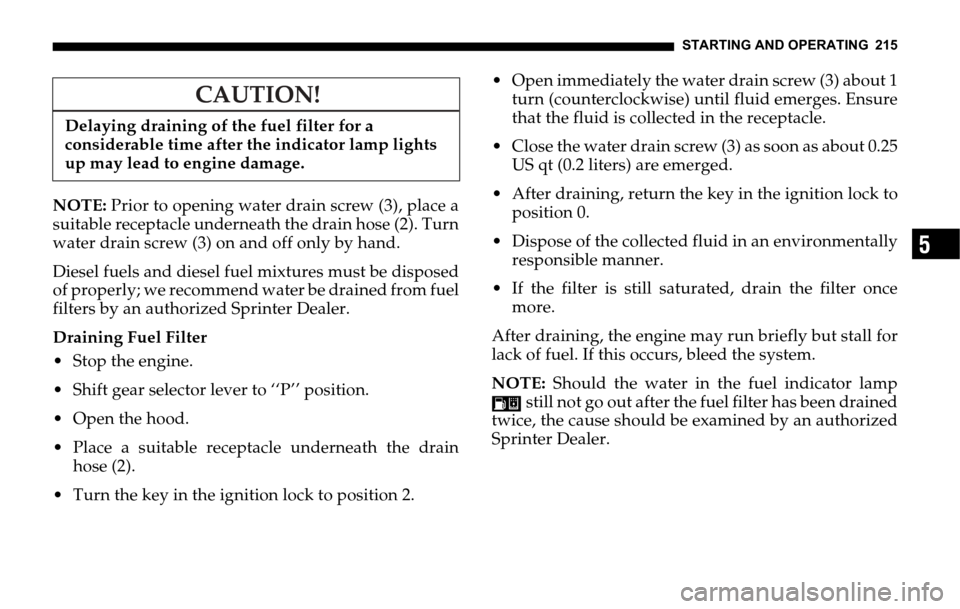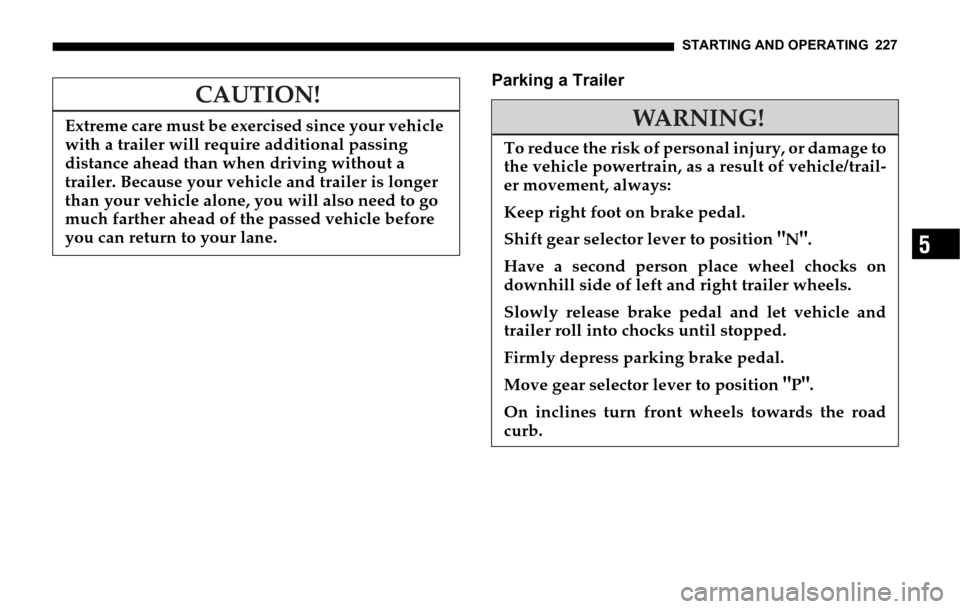stop start DODGE SPRINTER 2006 1.G Owner's Manual
[x] Cancel search | Manufacturer: DODGE, Model Year: 2006, Model line: SPRINTER, Model: DODGE SPRINTER 2006 1.GPages: 330, PDF Size: 10.82 MB
Page 209 of 330

STARTING AND OPERATING 209
5
To avoid damage to your vehicle, tires or chains,
observe the following precautions:
Because of limited chain clearance between tires and
other suspension components, it is important that
only chains in good condition are used. Broken
chains can cause serious vehicle damage. Stop the
vehicle immediately if noise occurs that could
suggest chain breakage. Remove the damaged parts
of the chain before further use.
Install chains as tightly as possible and then
retighten after driving about 1/2 mile (0.8 km).
Do not exceed 30 mph (50 km/h).
Drive cautiously and avoid severe turns and large
bumps, especially with a loaded vehicle.
Do not install tire chains on front wheels.
Do not drive for a prolonged period on dry
pavement.
Observe the tire chain manufacturer’s instructions
on method of installation, operating speed, and
conditions for usage. Always use the lower
suggested operating speed of the chain
manufacturer if different than the speed
recommended by the manufacturer.FUEL REQUIREMENTS
Use only commercially available vehicular diesel fuels
No. 2 or No. 1 (ASTM D 975 No. 2-D or No. 1-D).
NOTE: Because of its better quality the manufacturer
recommends the use of commercially available
vehicular diesel fuel No. 2.
For information on cold weather operation, contact
your authorized Sprinter Dealer.
WARNING!
Marine diesel fuel, Bio diesel fuel, heating oil or
the like must not be used.
Do not blend diesel fuel with marine diesel fuel,
Bio diesel fuel or heating oil.
The use of such non-approved fuels or blending
diesel fuel may result in malfunction or cause
engine damage. Damage or malfunctions
resulting from poor fuel quality or from blending
specific fuel additives are not covered by the
Sprinter Warranty.
Page 215 of 330

STARTING AND OPERATING 215
5
NOTE: Prior to opening water drain screw (3), place a
suitable receptacle underneath the drain hose (2). Turn
water drain screw (3) on and off only by hand.
Diesel fuels and diesel fuel mixtures must be disposed
of properly; we recommend water be drained from fuel
filters by an authorized Sprinter Dealer.
Draining Fuel Filter
Stop the engine.
Shift gear selector lever to ‘‘P’’ position.
Open the hood.
Place a suitable receptacle underneath the drain
hose (2).
Turn the key in the ignition lock to position 2. Open immediately the water drain screw (3) about 1
turn (counterclockwise) until fluid emerges. Ensure
that the fluid is collected in the receptacle.
Close the water drain screw (3) as soon as about 0.25
US qt (0.2 liters) are emerged.
After draining, return the key in the ignition lock to
position 0.
Dispose of the collected fluid in an environmentally
responsible manner.
If the filter is still saturated, drain the filter once
more.
After draining, the engine may run briefly but stall for
lack of fuel. If this occurs, bleed the system.
NOTE: Should the water in the fuel indicator lamp
still not go out after the fuel filter has been drained
twice, the cause should be examined by an authorized
Sprinter Dealer.
CAUTION!
Delaying draining of the fuel filter for a
considerable time after the indicator lamp lights
up may lead to engine damage.
Page 217 of 330

STARTING AND OPERATING 217
5
capacity of your vehicle, called the Gross Vehicle
Weight Rating (GVWR). The GVWR includes the
weight of the vehicle, all occupants, fuel and cargo.
The Certification Label also tells you about the front
and rear axle weight capacity, called the Gross Axle
Weight Rating (GAWR). The GAWR is the total
allowable weight that can be carried by a single axle
(front or rear). Never exceed the GVWR or GAWR
for either the front axle or rear axle.
Following is a discussion on how to work with the
information contained on the two placards with
regards to loading your Sprinter vehicle.Tire and Loading Information
WARNING!
Do not overload the tires by exceeding the speci-
fied load limit as indicated on the Tire and Load-
ing Information placard on the driver’s door B-
pillar. Overloading the tires can overheat them,
possibly causing a blowout. Overloading the tires
can also result in handling or steering problems,
or brake failure.
Overloading of tires is dangerous. Overloading
can cause tire failure, affect vehicle handling, and
increase the stopping distance. Use tires of the
recommended load capacity for the vehicle. Never
overload them.
The vehicle maximum load on the tire must not
exceed the load carrying capacity of the tire on
your vehicle. You will not exceed the tire’s load
carrying capacity if you adhere to the loading
conditions, tire size and cold tire inflation
pressures specified on the Tire and Loading
Information placard and this section.
Page 225 of 330

STARTING AND OPERATING 225
5
Towing a Trailer
There are many different laws, including speed limit
restrictions, having to do with trailer towing. Make
sure that your vehicle-trailer combination will be legal,
not only for where you reside, but also for where you
will be driving. A good source for this information can
be the police or local authorities.
Before you start driving with the trailer, check the
trailer hitch, break-away switch, safety chains,
electrical connections, lighting and tires. Also adjust
the mirrors to permit unobstructed view beyond rear
of trailer.
If the trailer has electric brakes, start your vehicle and
trailer moving slowly, and then apply only the trailer
brake controller by hand to be sure the brakes are
working properly.
When towing a trailer, check occasionally to be sure
that the load is secure, and that lighting and trailer
brakes (if so equipped) are functioning properly.
Always secure items in the trailer to prevent load shifts
while driving.Take into consideration that when towing a trailer, the
handling characteristics are different and less stable
from those when operating the vehicle without a
trailer. It is important to avoid sudden maneuvers. The
vehicle and trailer combination is heavier, and
therefore is limited in acceleration and climbing ability,
and requires longer stopping distances. It is more
prone to reacting to side wind gusts, and requires more
sensitive steering input.
In order to gain skill and an understanding of the
vehicle’s behavior, you should practice turning, stopping
and backing up in an area which is free from traffic.
If possible, do not brake abruptly, but rather engage
the brake slightly at first to permit the trailer to activate
its brake. Then increase the braking force.
Page 227 of 330

STARTING AND OPERATING 227
5
Parking a TrailerCAUTION!
Extreme care must be exercised since your vehicle
with a trailer will require additional passing
distance ahead than when driving without a
trailer. Because your vehicle and trailer is longer
than your vehicle alone, you will also need to go
much farther ahead of the passed vehicle before
you can return to your lane.WARNING!
To reduce the risk of personal injury, or damage to
the vehicle powertrain, as a result of vehicle/trail-
er movement, always:
Keep right foot on brake pedal.
Shift gear selector lever to position
"N".
Have a second person place wheel chocks on
downhill side of left and right trailer wheels.
Slowly release brake pedal and let vehicle and
trailer roll into chocks until stopped.
Firmly depress parking brake pedal.
Move gear selector lever to position
"P".
On inclines turn front wheels towards the road
curb.
Page 326 of 330

326 INDEX
Rear Seat Bench . . . . . . . . . . . . . . . . . . . . . . . . . . . . . 64
Security System with Towing and Passenger
Compartment Protection . . . . . . . . . . . . . . . . . . . . . . . 23
Audible Alarm . . . . . . . . . . . . . . . . . . . . . . . . . . . . . 24
Switching off the Alarm . . . . . . . . . . . . . . . . . . . . . . 24
Visual Alarm . . . . . . . . . . . . . . . . . . . . . . . . . . . . . . . 24
Service Products . . . . . . . . . . . . . . . . . . . . . . . . . . . . . 255
Disposal of Service Products . . . . . . . . . . . . . . . . . 256
Skid Control, Acceleration . . . . . . . . . . . . . . . . . . . . . 167
Sliding Door . . . . . . . . . . . . . . . . . . . . . . . . . . . . . . . . . . 30
Snow Chains . . . . . . . . . . . . . . . . . . . . . . . . . . . . . . . . . 207
Spare Wheel Location . . . . . . . . . . . . . . . . . . . . . . . . . 236
Special Maintenance Requirements . . . . . . . . . . . . . 307
Speed Control. . . . . . . . . . . . . . . . . . . . . . . . . . . . . . . . . 77
Sprinter Original Parts . . . . . . . . . . . . . . . . . . . . . . . . 255
SRS Malfunction Indicator Lamp . . . . . . . . . . . . . . . . 49
Standard Fuse and Relay Equipment . . . . . . . . . . . . 277
Starter Switch . . . . . . . . . . . . . . . . . . . . . . . . . . . . . . . . . 13
Starting the Engine . . . . . . . . . . . . . . . . . . . . . . . . . . . 144
Stopping the Engine . . . . . . . . . . . . . . . . . . . . . . . . . . 147
Storing Tires . . . . . . . . . . . . . . . . . . . . . . . . . . . . . . . . . 182Suggestions For Obtaining Service For
Your Vehicle . . . . . . . . . . . . . . . . . . . . . . . . . . . . . . . . . 312
Sun Roof
Electrical . . . . . . . . . . . . . . . . . . . . . . . . . . . . . . . . . . . 81
Mechanical Operation . . . . . . . . . . . . . . . . . . . . . . . 81
Sun Roof, Electrical . . . . . . . . . . . . . . . . . . . . . . . . . . . . 81
Switch Locations . . . . . . . . . . . . . . . . . . . . . . . . . . . . . 110
Switch,Starter . . . . . . . . . . . . . . . . . . . . . . . . . . . . . . . . . 13
TTachometer . . . . . . . . . . . . . . . . . . . . . . . . . . . . . . 101, 103
Telephone . . . . . . . . . . . . . . . . . . . . . . . . . . . . . . . . . . . . 84
Tie Down Rings . . . . . . . . . . . . . . . . . . . . . . . . . . . . . . . 54
Tire
Size . . . . . . . . . . . . . . . . . . . . . . . . . . . . . . . . . . . . . . 197
Tire and Loading Information . . . . . . . . . . . . . . . . . . 217
Tire Care and Maintenance . . . . . . . . . . . . . . . . . . . . 180
Tire Grip . . . . . . . . . . . . . . . . . . . . . . . . . . . . . . . . . . . . 176
Tire Inspection . . . . . . . . . . . . . . . . . . . . . . . . . . . . . . . 180
Tire Sizes for Sprinter Vehicles . . . . . . . . . . . . . . . . . 193
Tires . . . . . . . . . . . . . . . . . . . . . . . . . . . . . . . . . . . . . . . . 183
Alignment and Balance . . . . . . . . . . . . . . . . . . . . . 206
Aspect Ratio . . . . . . . . . . . . . . . . . . . . . . . . . . . . . . . 193